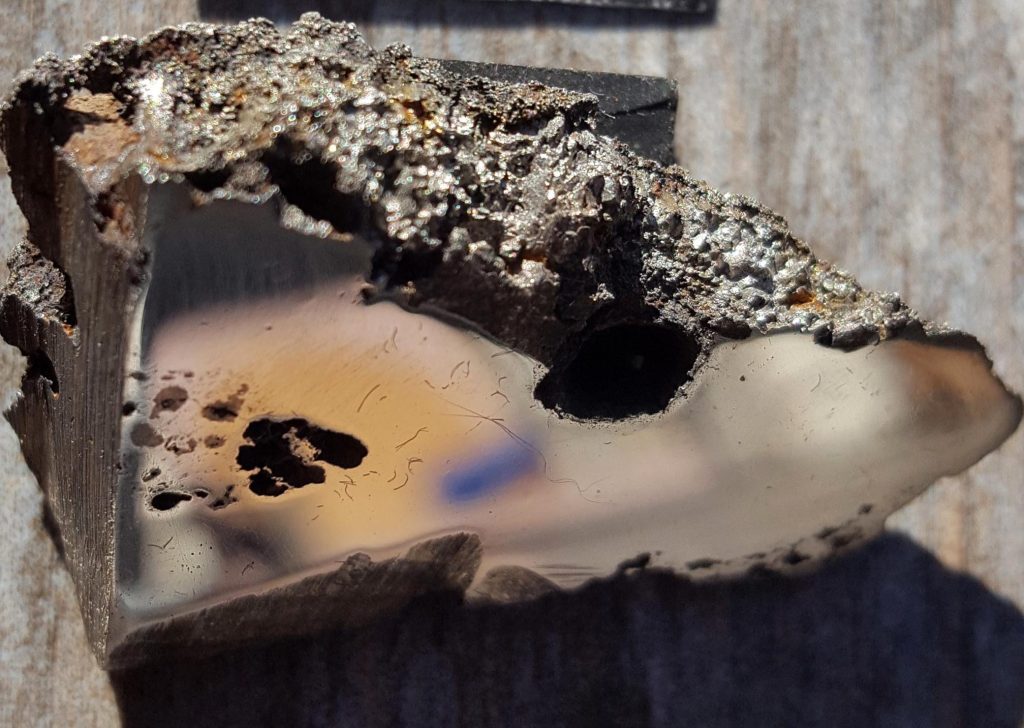Een stukje van de El Ali-meteoriet, nu in de Meteorite Collection van de Universiteit van Alberta, bevat twee mineralen die nog nooit eerder op aarde zijn gezien. Krediet: Universiteit van Alberta
Nieuwe mineralen ontdekt in een enorme meteoriet kunnen aanwijzingen onthullen voor de vorming van asteroïden.
Een team van onderzoekers heeft ten minste twee nieuwe mineralen ontdekt die nog nooit eerder op aarde zijn gezien in een meteoriet van 33.000 pond (15.000 kg) die in 2020 in Somalië is gevonden. Deze gigantische meteoriet is de negende grootste ooit gevonden.
“Als je een nieuw mineraal vindt, betekent dit dat de werkelijke geologische omstandigheden, de chemie van de rotsen, anders waren dan wat eerder werd gevonden”, zegt Chris Hurd, een professor aan het Department of Earth and Atmospheric Sciences en curator van de Alberta-meteoriet. verzameling. “Dat is wat dit opwindend maakt: in deze specifieke meteoriet heb je twee officieel beschreven mineralen die nieuw zijn voor de wetenschap.”
Een plakje van 70 gram van de meteoriet werd voor classificatie naar de Universiteit van Alberta gestuurd, waar de twee mineralen werden ontdekt. Het lijkt erop dat er al een mogelijk derde mineraal wordt bestudeerd. Hurd merkt op dat als onderzoekers meer monsters van de enorme meteoriet krijgen, er een kans is dat ze meer mineralen zullen vinden.
De twee nieuw ontdekte mineralen zijn elaliiet en elkinstantoniet genoemd. De voornaam, elaliite, komt van de meteoriet zelf, die officieel “HoogsteEen meteoriet omdat deze is gevonden nabij de stad Al-Ali in de regio Hiran in Somalië. Flock noemde elkenstantoniet het tweede mineraal naar Lindy Elkins-Tanton, vice-president van het Planetary Initiative aan de Arizona State University, professor aan ASU’s College of Earth and Space Exploration, en hoofdonderzoeker voor[{” attribute=””>NASA’s upcoming Psyche mission.

A slice of the El Ali meteorite contains two minerals never before seen on Earth. Credit: University of Alberta
“Lindy has done a lot of work on how the cores of planets form, how these iron-nickel cores form, and the closest analogue we have are iron meteorites. So it made sense to name a mineral after her and recognize her contributions to science,” Herd explains.
In collaboration with researchers at the University of California, Los Angeles (UCLA) and the California Institute of Technology (Caltech), Herd classified the El Ali meteorite as an “Iron, IAB complex” meteorite, one of over 350 in that particular category.
As Herd was analyzing the meteorite to classify it, he saw something that caught his attention. He brought in the expertise of Andrew Locock, head of the University of Alberta’s Electron Microprobe Laboratory, who has been involved in other new mineral descriptions including Heamanite-(Ce).
“The very first day he did some analyses, he said, ‘You’ve got at least two new minerals in there,’” says Herd. “That was phenomenal. Most of the time it takes a lot more work than that to say there’s a new mineral.”
Locock’s rapid identification was possible because the two minerals had been synthetically created before, so he was able to match the composition of the newly discovered natural minerals with their human-made counterparts.
Scientists are still examining the minerals in detail to determine what they can tell us about the conditions in the meteorite when it formed.
“That’s my expertise — how you tease out the geologic processes and the geologic history of the asteroid this rock was once part of,” says Herd. “I never thought I’d be involved in describing brand new minerals just by virtue of working on a meteorite.”
Herd also notes that any new mineral discoveries could possibly yield exciting new uses down the line.
“Whenever there’s a new material that’s known, material scientists are interested too because of the potential uses in a wide range of things in society.”
While the future of the meteorite remains uncertain, Herd says the researchers have received news that it appears to have been moved to China in search of a potential buyer. It remains to be seen whether additional samples will be available for scientific purposes.
Herd described the findings at the Space Exploration Symposium on November 21 at the University of Alberta’s ETLC Solarium.

“Amateur-organisator. Wannabe-bierevangelist. Algemene webfan. Gecertificeerde internetninja. Fanatieke lezer.”










More Stories
Mogelijk hebben we de eerste magnetische uitbarsting buiten onze Melkweg gedetecteerd
Starlink-missie dinsdag vanuit Cape Canaveral
Hubble viert zijn 34e verjaardag met een blik op de Kleine Halternevel